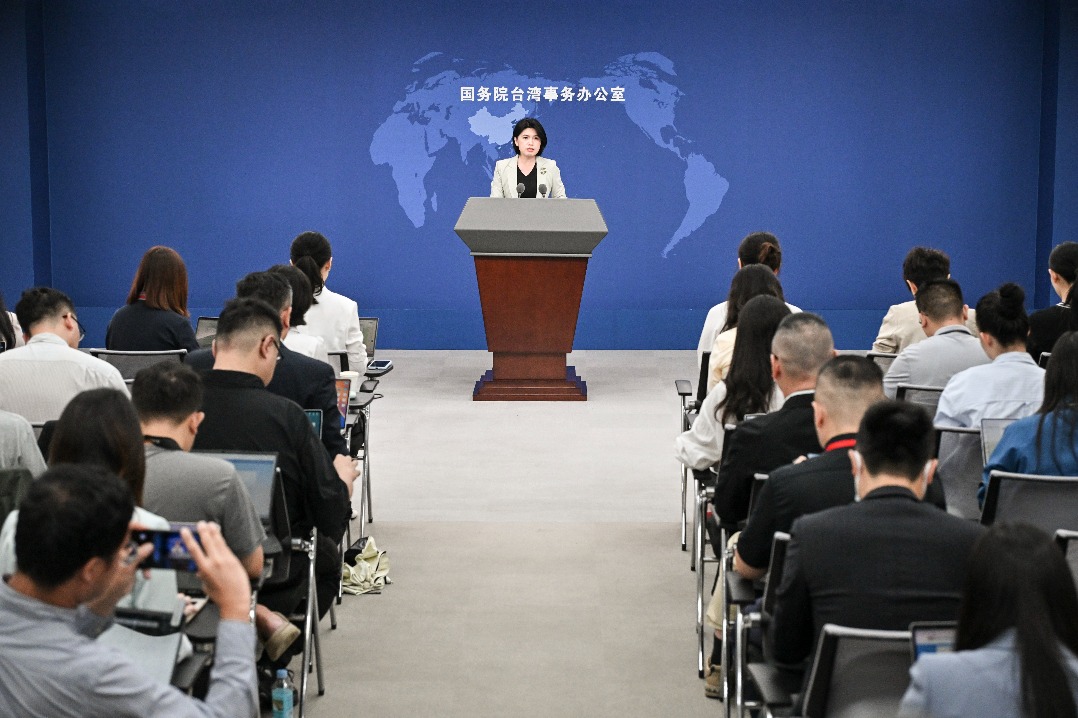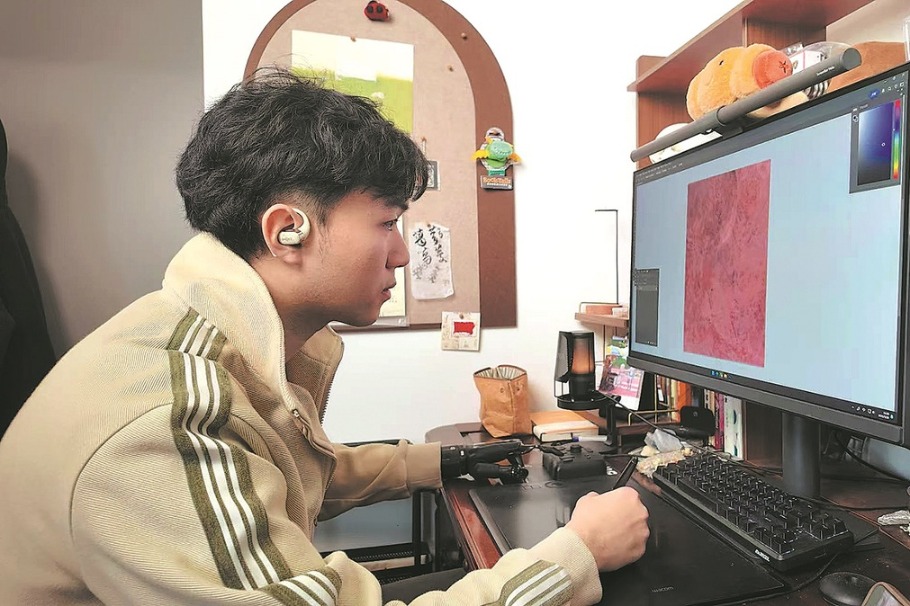Dream of astronautics rooted in kids' hearts
Nation's achievements in astronautics fueling children's interest in the universe and space travel

It was 9 am and long queues had formed at the Beijing Planetarium. As security staff opened the gate, people streamed in one after another.
It took effort for those people to visit the planetarium; daily visitors are limited to 7,200 and the window to buy a ticket is narrow. At 5 pm each day, the planetarium puts on sale entrance tickets for three days' time on its official WeChat account. Weekend tickets generally sell out within five minutes. Three of the parents stood in the queue said that they had set an alarm for 5 pm so as to secure tickets as quickly as possible.
As China has made one astronautic achievement after another, gaining astronautic knowledge has become increasingly popular among school pupils. Planetariums, astronautic exhibition centers and other public places where one can see related scale models are nowadays crowded with children and their parents.
Crowded exhibits
The exhibits in the Beijing Planetarium, for example, are designed in such way so that visitors can obtain knowledge logically along the way. Upon entry, there are models of the solar system, including the Sun and the eight planets, where visitors can get to know the planet where we live on and the star that we depend on for life.
Following this is an introduction to the deeper universe, where the Horsehead Nebula, the spiral galaxy and the Pleiades are printed on the wall.
Then are introductions to stars and planets outside the galaxy and some basic concepts, such as the gravitational lens that make humankind's space travel more convenient. At the China Science and Technology Museum (CSTM), there are life-size models of spaceships that enable humankind to travel into space. Visitors can go in and experience traveling among the stars. "I think I can drive a real spaceship when I am grown up, I am ready!" said Wang Chuwei, a 9-yearold boy, upon coming out of the animated driving cabin.
Elsewhere, and for a more historical perspective, there is the Ancient Observatory of Beijing, which was built in 1442 and served the Ming and Qing dynasties (1368-1911).There are eight astronomy observance devices made of bronze in the yard, plus exhibition materials of ancient astronomy in China.
"The starry night is attractive because of its infinity. Just think about the fact that there are more stars (in the universe) than if there were a 10-meter-thick layer of sand particles covering the whole surface of the Earth," said Zhou Binghong, a professor at the China Academy of Space Technology. "It is out of one's instinct to look deeply into the starry night."
Zhou also said that by popularizing astronautic science for children, those with the ability and interest can be selected to learn in that sector, thus getting the best talent working in the fierce contest of space technology. "When people realize they are working for the whole of humankind's journey into the universe, they will work with enthusiasm from the heart, which is irreplaceable," he said. "It is that enthusiasm that supports humankind's development into space."
Books for young and old
Besides exhibition visits, books are another good way for children to obtain knowledge about spaceships, stars and the universe.
On domestic book and electronics sales website JD.com, there is a book series called Seven Episodes on Astronautics, authored by famous astronautics writer Li Mingsheng, ranking fourth on the Top 10 pop-science best-seller list. Divided into Flying to the Space Port, Going out of the Earth Village, China's New Long March and four other books, the series tells stories about Chinese people's steps into space.
"My child likes it," said one of the more than 900 likes with comments. "I like it, too, because never before had we ordinary people known so much about our nation's history of exploring space. Parents can read it together with children," said another.
Hunan Science & Technology Press, a publishing house featuring pop-science books based in Changsha, Central China's Hunan province, has published a First Driving Force series, including more than 50 books related to space and spaceships. They have also translated a series of books from the English language, such as Hubble's Greatest Discoveries and Latest Images, and 50 Years of Man in Space, telling humanity's astronautics history.
Zou Li, a senior editor at HSTP, echoed the online comments: "Our pop-science books are for both children and their parents. With the progress of society, children gain knowledge in such a speedy way that it is increasingly common for parents to be unable to answer their questions. That's why modern pop-science books tend more to allow the parents to grow together with their children. I hope our books can serve that purpose well."
Even language-learning materials prefer to include space as their topic. To the Moon and Beyond, a book introducing astronautics and astronomy in English, has got more than 10,000 ratings on JD.com, making it one of the most influential English-learning books.
Unique lesson
On Dec 9, 2021, astronauts Zhai Zhigang, Wang Yaping and Ye Guangfu held their first open class aboard the Tianhe core module of the Chinese space station for pupils.
In the 50-minute online class, the three astronauts explained daily life in space, how to walk in a microgravity environment and showed the children how to recycle water, oxygen and carbon dioxide in their environment. Applause broke out among the 1,420-strong audience at the CSTM when one of the three astronauts poured out water, which formed into a perfect ball. Applause broke out again when they put an effervescent tablet into the water, which fizzed into bubbles. But the bubbles did not burst and instead stayed intact.
The open science lesson was broadcast live to the nation. On domestic video-sharing website bilibili.com alone, the open course was watched at least 6 million times, with more views on other platforms and TV channels.
For Shi Hao, a space specialist at China Aerospace Science and Technology Corporation, the growing desire of school pupils to pursue knowledge about space reflects the growing potential of China in exploring the universe in the future.
"I still remember how impressed I was by the launch of Shenzhou VI in September 2005, which was carried by a Long March 2F rocket into space. I also attended the speech of the crew. From then on, I have carved out the dream of pursuing my career in astronautics from the bottom of my heart," Shi said. "For many people like me, this is not only a job, but a lifelong addiction and dedication. It is of uttermost importance to let Chinese youths touch astronautics during their childhood so as to sustain the building of talents."
He was echoed by Zhou, who places high hopes on the future of China's space industry. "We have a population of 1.4 billion, of which more than 200 million are pupils at school. By inspiring their enthusiasm, China will get an abundant supply of talents for the national space research team."
"Chinese people will step further in the universe and the hope lies in our children," he added.



Today's Top News
- Tajikistan looks to China for deeper ties
- High-tech manufacturing lifts industrial profits
- Avenue blooms with flowers to mark victory
- Mainland slams DPP for distorting WWII history
- Northeast Asia trade in focus at Jilin expo
- Organic agriculture forum unites global experts in Datong






























